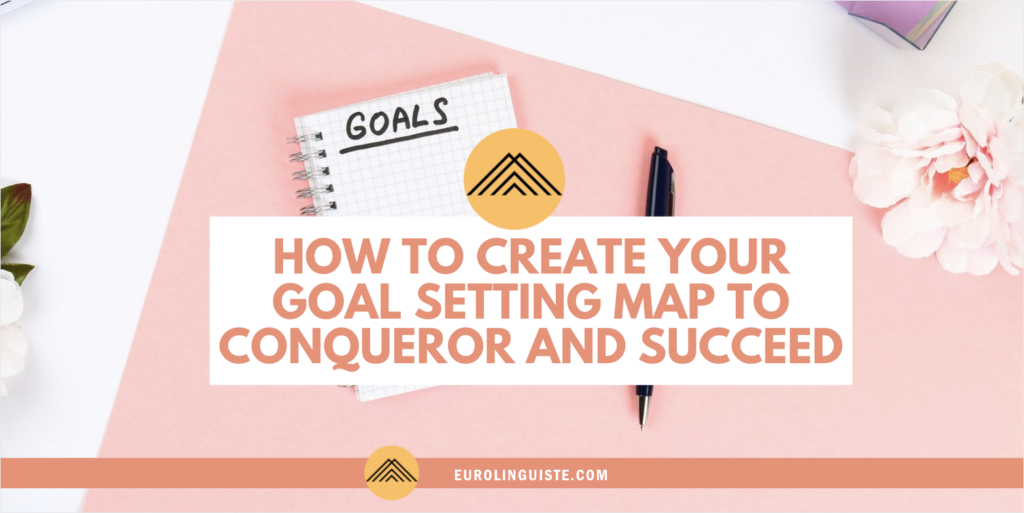How to Create Your Goal Setting Map to Conqueror And Succeed

My name is Shannon Kennedy and I'm the language lover,…
The following is a guest post from Caitlin Sacasas.
How’s your goal setting strategy? Do you stick with your goals? Or do you have a hard time following through, and seem to get lost along the way?
If you fall in the latter category, you’re definitely not alone. While most people are used to setting some kind of goal for themselves, many struggle to make actual change so their goals happen.
But even if you’re someone who normally sticks to your goals, there are always ways to make goal setting more effective.
And since that’s what our Quest for January is all about, let’s dive in.

Goal Setting Definition: What is Goal Setting?
This may seem obvious, but let’s talk about what exactly is a goal.
As a fitness trainer by trade, I often have clients come to me saying: “My goal is to lose weight.”
The thing is… That isn’t a goal. That’s an intention, an idea. A thought.
A popular goal-setting theory is starting from what you want to achieve, and what your life would look like at that endpoint. From there, you flesh out a SMART goal. (And we’ll talk about SMART goals in a moment.)
But to me, that’s not enough. If I ask my clients who want to lose weight, “What does your life look like when you achieve that?”… They likely won’t have a clear answer. It’ll be pretty vague, or something like, “Well, I’d look better” or “I’d feel more confident.”
Those answers aren’t very motivating are they?
No. It’s because the goal is too vague.
So when it comes to language learning, our goal-setting strategy needs to be clear and concise. It can’t be something vague like “to be fluent in X language.” What does fluency look like for you? What is your measure of fluency? It won’t be the same for everyone.
So, my goal-setting definition is: What concrete action can I complete when I reach this goal?
For losing weight, the action might be that when I lose 10 lbs, I’ll also be able to run a mile or squat 100 lbs or something actionable that goes along with it.
As for language learning, the same thing applies: “I’ll have reached my goal when I can train someone in Japanese and follow along with Japanese workout videos with ease.”
Goal Setting: SMART Goals
SMART goals are one of the most popular ways to set goals. SMART stands for Specific, Measurable, Attainable, Relevant, and Time-bound.
So going back to “I want to be fluent.” That isn’t a smart goal, because it doesn’t meet any of the above definitions. But if we wanted to make it SMART, we could say…
Specific: I want to talk comfortably about fitness and be able to train someone in Japanese.
Measurable: I’ll know I can do this when I can follow along with a workout video and understand it with ease.
Attainable: I can achieve this by practicing vocabulary and grammar patterns I hear other trainers use in Japanese.
Relevant: This goal is relevant to me because I’d like to be able to train in Japan one day.
Time-bound: I’ll achieve this goal in 6 months.
So the whole goal, simplified, becomes: “I want to be comfortable training in Japanese within 6 months of study by watching Japanese workout videos so I can one day train in Japan.”
You can do this too! Here’s a general SMART goal setting template:
“I want to (specific and measurable) within (time-bound) of practice in my language by (attainable) so I can (relevant).”
How to Start Setting Goals for Language Learning
Okay, so how can you start setting goals for language learning that you’ll actually stick with? Well, here are some tips for sticking with your goals, and strategies to make them happen.
1. Create a Big Goal and a Little Goal
What’s your BIGGEST dream with your language? Is it to travel to the country where it’s spoken, and chat with natives and find the best hole-in-the-wall places to eat? Is it to work in the country? That’s your big goal.
But to feel motivated to stick with your goal, you should also create little goals that lead you to the big one.
So if your goal is to get skilled enough to work in the country, that could take a while. But if your little goal is to learn how to introduce yourself to a potential employer, then that’s a small goal you could work towards and succeed at much faster.
Start with one small goal, and then pick the next one once you’ve completed it.
2. Think About Your Goals Like Flights of Stairs
I talked about this in our podcast episode on goal-setting, too. But I like to think of goals as flights of stairs.
The bottom is where I’m at, and the top is that gorgeous rooftop view — my end goal. The platforms between each flight of stairs are my smaller goals that help lead to my end goal. And each step is the smallest individual actions I need to take to keep climbing.
I’ll map this out as best I can, and adjust as I climb my stairs and reach new heights with my goals. But the beauty of this strategy is that the planning upfront saves me time and decision making later.
If I’m ever confused as to what to do to work toward my goal, I can look at my map of stairs and see what I need to do.
If I ever feel so worn out or decision-fatigued (and I often do), I don’t have to make a decision — it’s already mapped out, and I just have to follow through.
3. Write It Down Every Single Day
Every day, pull out your journal and write down your language learning goals. Bonus points if it’s in your target language.
This reinforces in your brain what you need to accomplish and work towards today, and writing it down helps make it feel more concrete and tangible.
4. Habit Stack
If you struggle with having enough time or sticking with a new goal, try pairing it with something you already do and love.
I learned this method from Atomic Habits by James Clear and it’s life-changing.
Instead of making time for something new, you’re including your language with something you already make time for.
My best example is my morning routine: I wake up, I start my pot of coffee and I meditate. Then after I meditate, I study vocabulary in my language while drinking my coffee.
I’ve actually stacked several habits here. I first created a consistent meditation routine by pairing it with the act of starting my pot of coffee and meditating while I wait for it to brew.
Then, I’ve habit stacked my vocabulary drills with my meditation and coffee. I do this because meditating clears my head, while coffee wakes me up. I feel most calm and focused at this point in my day, so I study vocabulary then.
I remember what I learn much better doing this and I save time.
5. Set Your Environment Up For Your Success
This was a big one for me. My house can be very chaotic, and I noticed it affected my ability to focus (I work from home).
So, I set up an office space and I only work in that space.
That helped my productivity levels, and also helped keep all the things I need in one place. So I wasn’t wasting time looking for them or being distracted.
The same can be done with language learning. Make it as easy as you possibly can.
I have my favorite language learning apps right on the home screen of my phone. So, any time I have a moment to myself, I see it right away and remember to work on my language.
Likewise, at home, I have a specific spot I like to sit in when I study. And I tend to keep a Japanese book on my bedside table so that if I feel like reading before bed, I can grab it and read a page or two.
These small changes add up to a lot of little touchpoints in the language!
Join our Goal Setting Quest!
Ready to master your language learning goals and reach new heights with your language? Join us in Language Conqueror! Every month, we go on a new Quest — a language learning challenge — around a topic or passion to help you learn through your hobbies! It’s passion-driven language learning, and it’s powerful.
And you can join our Go-Getter Goal Setting Quest hosted by Shannon! It’s all about developing your language learning Map to guide you through the rest of your Quests. Plus, it comes with an amazing goal setting worksheet and workbook to help you make the most of your journey.
What are your language learning goals? Leave us a comment below and let us know!
My name is Shannon Kennedy and I'm the language lover, traveler, and foodie behind Eurolinguiste. I'm also the Head Coach of the Fluent in 3 Months Bootcamp, co-founder of Women in Language, and former Resident Polyglot at Drops.






